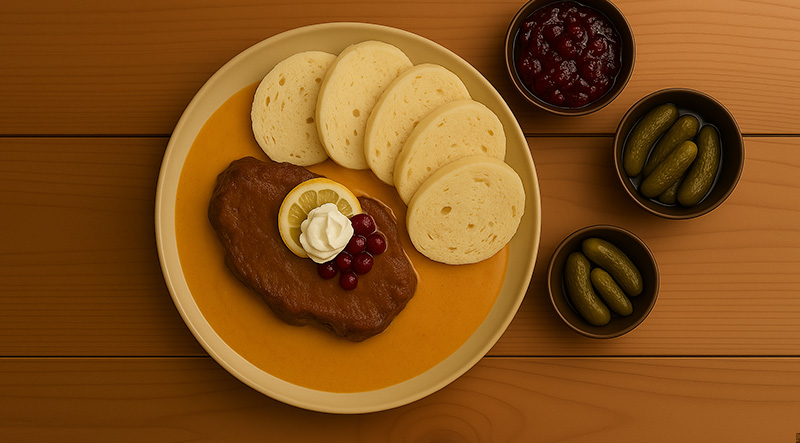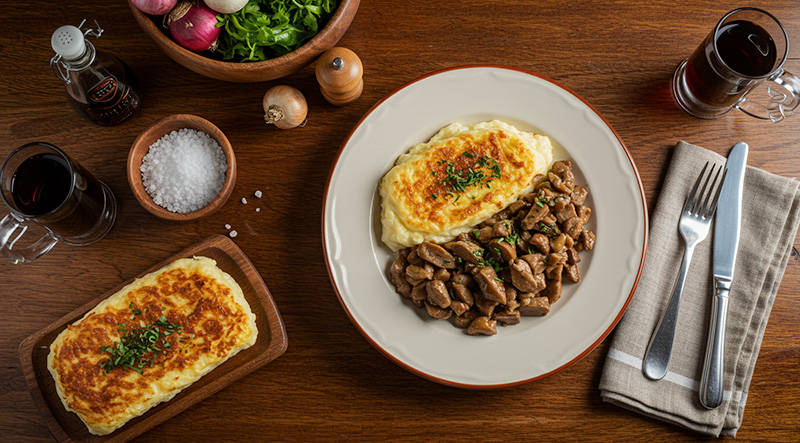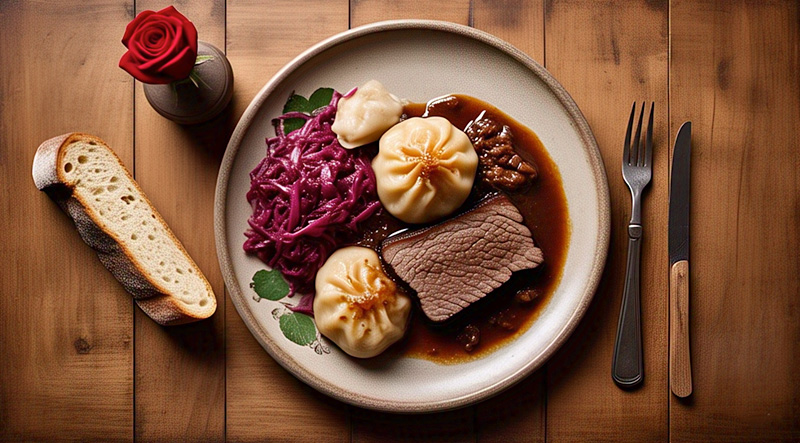Svíčková na Smetaně, the national dish of the Czech Republic, is a rich and comforting masterpiece that perfectly blends savory and creamy flavors. This dish features tender, slow-cooked beef sirloin smothered in a velvety, creamy sauce made from carrots, onions, and aromatic herbs, all enhanced with a touch of vinegar and spices. It’s traditionally served with soft, pillowy knedlíky (dumplings) that soak up every drop of the flavorful sauce, while a spoonful of tangy cranberries and a dollop of fresh whipped cream add the perfect sweet and sour balance. With each bite, Svíčková offers a taste of Czech tradition and warmth, making it the ultimate indulgence for any meal. Read More...
The History of Svíčková na Smetaně – Czech Republic’s National Dish:
Svíčková na Smetaně is more than just a dish—it’s a symbol of Czech culinary tradition, enjoyed for centuries as a hearty, flavorful meal. With its rich history, comforting flavors, and balance of textures, this dish has remained a beloved part of Czech dining culture, perfect for both everyday meals and festive occasions. It’s a true reflection of the country’s love for simple, yet deeply satisfying food, crafted with skill and patience.
Origins of Svíčková na Smetaně:
The origins of Svíčková na Smetaně date back to the 18th century, a time when Czech cuisine was greatly influenced by the broader culinary trends of Central Europe, especially the Habsburg Empire. During this period, noble and wealthy families began to explore more refined cooking methods, introducing the use of cream and spices into their dishes. Svíčková, meaning “sirloin” in Czech, is based on the tradition of roasting beef and serving it with a rich, creamy sauce—an influence shared across many European cuisines.
Svíčková, in its early forms, was a dish often reserved for special occasions, as it involved expensive cuts of beef, along with the preparation of a labor-intensive sauce made with vegetables, herbs, and cream. It became a staple at royal feasts and lavish dinners, but over time, it found its place in Czech homes as a dish enjoyed by families and communities.
A Blend of Traditions:
The dish’s key components reflect the diverse cultural influences that shaped Czech cuisine over the centuries. The creamy sauce, which is made from carrots, onions, celery, and a mixture of aromatic herbs, shows the influence of French culinary techniques, which were prized in European kitchens during the 18th and 19th centuries. The addition of vinegar and spices such as pepper, bay leaves, and thyme gave the dish its distinctive balance of flavors.
Moreover, the iconic accompaniment—knedlíky, or Czech dumplings—completes the dish and represents another deep-rooted Czech tradition. Knedlíky are a symbol of Czech comfort food, made from flour, bread, and milk, and are essential in soaking up the rich sauce that characterizes Svíčková na Smetaně. The practice of serving the dish with sweet-tart cranberries and a dollop of whipped cream is a Czech signature that adds both sweetness and richness to the meal.
Svíčková and Czech Identity:
While Svíčková na Smetaně initially gained popularity among the upper classes, it soon became an integral part of Czech home cooking. The dish embodies the heart of Czech hospitality, where families gather around the table to enjoy good food, share stories, and celebrate togetherness. Today, it is enjoyed by Czechs of all walks of life, often prepared for special occasions such as birthdays, holidays, and weddings, as well as served in Czech restaurants around the world.
In fact, the dish is so iconic that it’s often considered the unofficial national dish of the Czech Republic. Despite the country’s rich culinary heritage, Svíčková na Smetaně is the dish that best represents Czech comfort food—a combination of tender beef, creamy sauce, and perfectly matched sides that satisfy the soul. The inclusion of cranberries and whipped cream adds a unique Czech twist, enhancing the overall flavor and elevating this dish from a simple roast beef to a culinary celebration.
Svíčková in Modern Times:
In modern-day Czech cuisine, Svíčková na Smetaně continues to be a treasured dish. While the basic recipe remains unchanged, many variations exist, with some cooks adding different spices or adapting the sauce to suit contemporary tastes. It is still commonly prepared for family gatherings, national holidays like Christmas, and celebrations. Czechs living abroad often prepare Svíčková as a way of staying connected to their roots, offering a taste of home wherever they may be.
In Czech restaurants, Svíčková na Smetaně is often presented with the same reverence and attention to detail as it has been for centuries. Its preparation remains a labor of love, with chefs taking time to slow-cook the beef and make the sauce from scratch, often using traditional methods passed down through generations. Whether served in a humble home or a gourmet restaurant, the essence of the dish remains the same: a warm, satisfying, and deeply flavorful meal.
Conclusion:
Svíčková na Smetaně is not just a dish—it is a piece of Czech history. From its royal beginnings to its place as a beloved family meal, it represents the essence of Czech hospitality, tradition, and culinary craft. Every bite of tender beef, rich sauce, and soft knedlíky is a celebration of the country’s deep-rooted food culture. As a dish that has stood the test of time, Svíčková na Smetaně remains a comforting, flavorful reminder of the Czech Republic’s proud culinary heritage, enjoyed by generations past and present.
Prepare the Beef:
Cook the Vegetables:
Deglaze the Pot:
Simmer the Beef:
Make the Sauce:

Finish the Sauce:

Slice the Beef:

Serve:
Tips for the Perfect Svíčková:
Enjoy your Svíčková na Smetaně, a delicious taste of Czech tradition and comfort food!
The preparation time for Svíčková na Smetaně is approximately 20-30 minutes for chopping the vegetables and preparing the beef. The beef needs to be browned, and then the vegetables and liquids are added to simmer with the beef for about 2 to 2.5 hours until tender. After the beef is cooked, the sauce is pureed and simmered with cream for an additional 10-15 minutes to thicken and incorporate the flavors. Overall, the total time from start to finish is about 2.5 to 3 hours, with the majority of this time spent cooking the beef slowly to achieve maximum tenderness.
A single serving of Svíčková na Smetaně, based on the recipe provided, contains approximately 600-800 calories. This estimate includes the tender beef sirloin cooked in a rich, creamy sauce made from vegetables, beef broth, and heavy cream, served with traditional Czech dumplings (knedlíky). The calorie count may vary depending on the size of the beef portions, the amount of cream and butter used in the sauce, and the serving size of the dumplings. The addition of cranberries and whipped cream can also slightly increase the total calorie count, but the dish remains a satisfying, hearty meal full of flavor and comfort.







